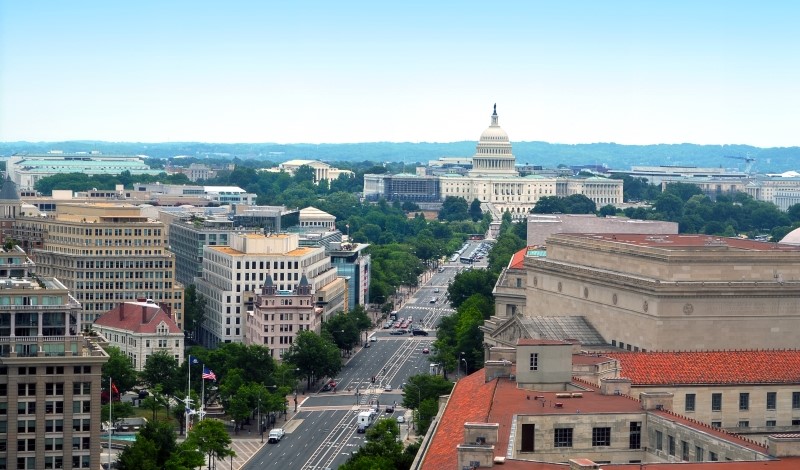
The hidden nature of the administrative state contributes to misperceptions of important government policies.
Why is the federal government so unpopular?
For many Americans, the answer to this question appears self-evident—the government is unpopular simply because it does a bad job. As law professor Peter Schuck writes, “across many different policy domains, the public perceives poor governmental performance – and generally speaking, the public is correct in this view.” Another prominent perspective focuses on ideological movements, primarily (though not exclusively) on the political right, that for decades have worked to sow distrust in government through anti-government rhetoric and actions designed to undermine government’s effectiveness.
Although there is some truth to both of these perspectives, they do not tell the whole story. Another major factor is that even when the government is effective in providing benefits or addressing social problems, few Americans understand its achievements. For instance, consider President Joseph R. Biden’s signature legislation, the Inflation Reduction Act (IRA), which delivers historic investments in combatting climate change, curbs prescription drug prices, and expands subsidies to obtain health insurance. These are undeniably important achievements. Yet public opinion surveys have consistently shown that most Americans have no idea what this law does or how it will benefit them.
Nor is this an isolated incident. For years, polling found a lack of awareness of President Barack Obama’s signature legislation, the 2010 Patient Protection and Affordable Care Act (ACA), which represented the largest expansion in health insurance coverage since the enactment of Medicaid and Medicare and drove America’s uninsured rate to historic lows. It was only when Republicans came close to repealing the ACA in 2017 that enough public support emerged to save the law—barely.
Government also succeeds in other quotidian yet important ways, ranging from protecting Americans from airline and traffic accidents to ensuring clean air to funding the infrastructure and investments that enable the local weather report. Yet most of us tend to take these achievements for granted or to overlook them entirely.
Why are more Americans not aware of the ways that government succeeds? And why does the government not do more to make the public aware of its successes?
As we argue in a recent article in the Wisconsin Law Review, an important part of the explanation is that Americans are not tuned into where most of the work of government is being done: the collection of agencies known as the “administrative state.” The administrative state comprises the agencies that deliver or oversee public benefits and services—for example, the Postal Service, the Social Security Administration, the Centers for Medicare and Medicaid Services—and the agencies that regulate industry to promote safety, health, and welfare—such as the Environmental Protection Agency (EPA), the Securities and Exchange Commission, and the Federal Trade Commission.
Although the administrative state’s role in implementing laws and government programs is well known to policy insiders, we argue that the critical work that federal agencies do is submerged—to borrow a term coined by political scientist Suzanne Mettler. That is to say, it is hidden from public view, making it difficult for Americans to perceive it or to understand its day-to-day effects on their lives. Despite agencies’ responsibility for the vast bulk of government work (including implementing statutes such as the IRA and the ACA), it is extremely difficult for even the most informed Americans to appreciate the extent to which agency actions affect their lives. As a result, Americans tend to underestimate the extent to which they benefit from government programs either because they do not recognize that they are receiving these benefits or because they are not aware that the benefits are being provided by the government. It is partly because of this submergence that the political response to several key U.S. Supreme Court’s recent decisions constraining the administrative state has been so muted, despite the danger that these decisions will ultimately render government less effective.
The administrative state is submerged in two primary ways.
First, administrative agencies are often unwilling or unable to communicate effectively with the public due to a confluence of legal constraints and doctrines, resource limitations, and political incentives. Consider, for example, the Supreme Court’s recently fashioned major questions doctrine, which subjects “major” agency actions to more significant judicial scrutiny. The Court has specifically signaled that novel agency actions are more likely to be viewed as “major.” This creates obvious incentives for agencies to frame their actions as neither major nor novel.
Agencies are already taking such steps. For instance, in tweeting out an announcement of its proposed replacement for the Clean Power Plan vacated in West Virginia v. EPA, the EPA press office responded to questions about why the plan did not have a “fun little name” like the Clean Power Plan by emphasizing that the rule took a “[t]raditional approach” and therefore had a “traditional name.” (EPA’s new power plant rule is in fact inelegantly titled: “New Source Performance Standards for Greenhouse Gas Emissions From New, Modified, and Reconstructed Fossil Fuel-Fired Electric Generating Units; Emission Guidelines for Greenhouse Gas Emissions From Existing Fossil Fuel-Fired Electric Generating Units; and Repeal of the Affordable Clean Energy Rule.”) This is despite the fact that these regulations were genuinely new—they would be the first government regulations of carbon emissions from existing power plants—and are predicted to deliver up to $85 billion in climate and public benefits. Given the Supreme Court’s recent decisions, it is reasonable for EPA to downplay the significance of its work, but this only makes it harder for the public to understand what EPA is up to.
Or consider the array of political constraints preventing agencies from publicizing their own accomplishments. One feature of modern “presidential administration” is that presidents typically claim credit for popular agency actions, while distancing themselves from agency failures. For example, when inflation was alarmingly high in January 2022, President Biden declared that the job of fighting inflation “rests with the Federal Reserve.” But when inflation started to fall in July 2023, President Biden took credit for the decline and celebrated it as “Bidenomics in action.” Similar dynamics exist in Congress. When Congress holds a hearing that focuses on the work of a federal agency, it is typically because Congress thinks the agency has done something wrong. As Jerry Mashaw and David Harfst put it in their classic book, The Struggle for Auto Safety, “administrators have few reliable political allies.” The overwhelmingly negative scrutiny that agencies receive when things go wrong in turn likely compounds agency officials’ hesitancy to boldly tout their own achievements for fear that doing so will backfire and create negative publicity when those achievements run out. Blame avoidance creates risk aversion and makes agencies more hesitant to tout their own achievements. They may decide it is better to stay off the public’s radar screen altogether.
Second, agency actions themselves are often designed or implemented in ways that obscure what agencies are doing or what role they are playing. For instance, despite numerous government initiatives designed to encourage agencies to use simple and straightforward language, many regulations (and accompanying explanations of these regulations) are still incomprehensible to the general public. This is in part due to the incentives created by administrative law, which places no limits on the information parties can submit in the regulatory process. This creates incentives for both agencies and affected interest groups to flood the rulemaking process with excessive information. And although agencies are generally required to provide an opportunity for the public to comment on their proposed rules, and the Biden administration has made real efforts to expand public engagement, public participation typically remains low (outside of a few highly salient rules). Agencies have also grown increasingly reliant on private contractors, behavioral nudges, and private standards (standards developed by industry or nongovernmental organizations which are then incorporated by reference into agency rules), all of which tend to make it more difficult for the public to notice agency actions or even to recognize actions as ones taken by the government. The process feels complex because it is.
Perhaps some degree of asymmetry in the public’s ability to appreciate government failures and successes is inevitable. Humans have a well-established tendency to pay more attention to bad events than good ones, sometimes referred to as negativity bias. Moreover, when it comes to regulatory policy or public health, it is much harder to notice the disasters that regulators or public health authorities prevent than those they fail to prevent. It is unrealistic to expect the public to ever fully appreciate the many things that government does behind the scenes given all the demands on our attention.
Yet, we believe agencies can and should do more to inform the public about their substantive expertise, the benefits they provide, and how to participate in administrative processes. New Deal programs such as the Works Progress Administration and the Civilian Conservation Corps once employed millions of Americans and built infrastructure all around the country that is still in use today proudly branding such projects as the work of government agencies. Tellingly, recent research suggests that such programs had a greater political impact when the government directly hired workers, making the programs more traceable to the government, than when they merely subsidized private companies’ hiring of workers.
Today, at the very least, agencies can reduce their reliance on private contractors, write regulatory preambles in ways that are easier for the public to understand, and do more to proactively solicit the public’s participation in the regulatory process. Congress and the judiciary should also consider scaling back some of the legal constraints that prevent agencies from communicating effectively with the public or that encourage agencies to make their actions less salient and traceable. These efforts could include revisiting and perhaps repealing laws targeting agency “propaganda,” which in some cases are arguably overbroad, as well as more general administrative law doctrines that have the effect of chilling agency communications. If the Supreme Court is unwilling to abandon the major questions doctrine altogether, it could, at the very least, cease relying on agencies’ communications to the public as indicia of “majorness,” which has the effect of incentivizing them to downplay their own actions. Outside groups such as the American Bar Association can do more to reward civil servants’ accomplishments and to inform the public about the non-political nature of the work they do.
Of course, these steps cannot fully restore public trust in government—there will still be ideological or partisan attacks on the government, and of course sometimes the government will fail. Yet improving the public’s awareness of the important work undertaken by agencies must be part of the solution. Given the importance of public trust for a healthy, functioning democracy, the stakes could not be higher.
This essay is jointly published in Can We Still Govern?, a Substack produced by Professor Don Moynihan at the University of Michigan and that is dedicated to improving the quality of government and public policy and to reducing administrative burdens.





